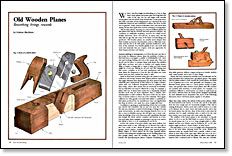
Synopsis: Old wooden planes can constitute an invaluable workshop resource for today’s woodworker. Graham Blackburn begins his article by talking about how to find and how to recognize a usable or refurbishable tool. Collectors frequently look for qualities other than utility, so worthwhile tools may be offered for a song. He divides planes into three basic groups (bench planes, molding planes, and special-purpose planes) and talks about how each type is used and the subcategories of planes in each major group. He explains how to disassemble planes to clean them up, oil or wax them, sharpen the iron, and check the tote and wedge.
When I was first taught woodworking as a boy in England, metal planes and power saws had long been the order of the day, but we still began with wooden bench planes and the whole array of hand saws. In the years since, the older tools have all but disappeared—not only from the more traditional classroom and tradesman’s toolbox, but from circulation in general. Today, many woodworkers don’t even know their names, far less their application and the techniques of using them.
Old wooden planes, meaning not only secondhand planes but also planes that may be obsolete and even genuine antiques, can constitute an invaluable workshop resource for today’s woodworker. Moreover, these old tools are, in many cases, the last link with an age that saw some of the finest woodworking ever produced. Old wooden planes are usually much cheaper than their modern successors. But they have more to offer than economy, and that has to do with pride, personal satisfaction, and a love of the material. You benefit greatly if you can work with tools and materials that you respect, tools you appreciate for their beauty and their rich history.
Anyone seeking to incorporate a tool from the past into his or her work, for whatever reason, faces the problem of where to find and how to recognize a usable or refurbishable tool. Once you start looking, finding old tools is the easiest part. They crop up all over the place: in antique shops, junk shops, flea markets, yard sales, auctions, and even in modern tool supply houses. What is harder is being able to know if what you have found might be of any use. Buying an old tool isn’t like buying your first router, complete in its box with attachments and instructions. Resist the temptation to buy the first old plane you come across until you have studied the matter a little.
Hand in hand with potential utility goes the question of price. Collectors and antique hunters have helped preserve many tools that might otherwise have disappeared, but their interest has often raised the price capriciously, so that utility is no longer commensurate with cost. Collectors frequently look for qualities other than utility, which often means that an eminently worthwhile, but uncollectible tool may be offered for a song. For example, a plane with lots of shiny brass screws but a hopelessly checked wooden stock may be more expensive than a simpler, lessadorned plane in solid condition. The prices of the two are, therefore, in inverse relation to their use to the craftsman. Then again, collectors are often greatly concerned with makers. A perfectly usable plane produced by one manufacturer may cost significantly less than an inferior one made by a more sought-after firm.
In addition to gaining an understanding of how the tool works, you should also remember that its true cost must also include the time you may have to spend refurbishing it.
From Fine Woodworking #57
For the full article, download the PDF below:
Fine Woodworking Recommended Products

Veritas Wheel Marking Gauge

Olfa Knife

Stanley Powerlock 16-ft. tape measure





















Log in or create an account to post a comment.
Sign up Log in